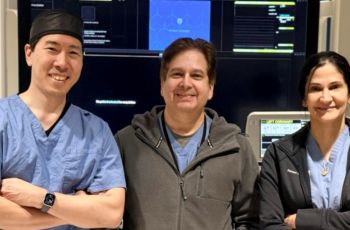WASHINGTON – The George Washington University Hospital (GW Hospital) is bringing the most advanced brain imaging software platform for identifying treatment options for stroke patients to the District. The RAPID CT Perfusion software is a new class of automated brain imaging software that allows doctors to quickly visualize reductions in blood flow to the brain and early signs of brain injury. GW Hospital is the first and only in the District to have this software.
“A vital part of our mission at GW Hospital is to bring advanced technology to our patients to enhance their care and improve outcomes,” says Kimberly Russo, Chief Executive Officer/Managing Director of GW Hospital. “The implementation of this new software is one more way that we are fulfilling this mission and ultimately, improving care for those affected by stroke.”
On the basis of recent studies, the American Heart Association and American Stroke Association have approved new treatment guidelines, meaning more people who have had an ischemic stroke could be eligible for life-saving clot removal and dissolving treatments.
“Thanks to the use of this tool and recent research, we are able to provide expedited, lifesaving treatment to individuals whom previously may not have been deemed candidates,” says Kathleen Burger, MD, Director of the GW Hospital Comprehensive Stroke Center. “This software increases our ability to make the best patient care decisions.”
The prior treatment window for mechanical thrombectomy was up to six hours. However, based on this groundbreaking research,select patients with salvageable brain tissue identified through advanced imaging such as provided by the RAPID platform, are now eligible for treatment up to twenty-four hours after they were last seen well.
“GW Hospital is one of the very few tristate hospitals with a neurointerventional radiology team on call 24/7 to perform minimally invasive procedures and treat complex strokes,” says Dimitri Sigounas, MD, neurosurgeon and interventional neuroradiologist at GW Hospital. “This new technology allows us to plan and prepare for these procedures more quickly and precisely, ultimately resulting in improved outcomes for our patients.”
The RAPID platform also enables physicians to easily communicate about the extent of a patient’s blood flow changes in the brain. Results are immediately available to doctors via email (devoid of private health information) for viewing on any device.
“During a stroke, minutes matter. Clot removal and dissolving treatments greatly enhance outcomes for stroke patients,” says Henry Kaminski, MD, Chair of the Department of Neurology. ‘The quicker we can bring this treatment to the patients who will benefit, the better outcomes patients will have.” GW Hospital is already nationally recognized for its stroke care. It is one of less than three percent of U.S. hospitals designated a Comprehensive Stroke Center by The Joint Commission.
This release is posted courtesy of GW Hospital.


